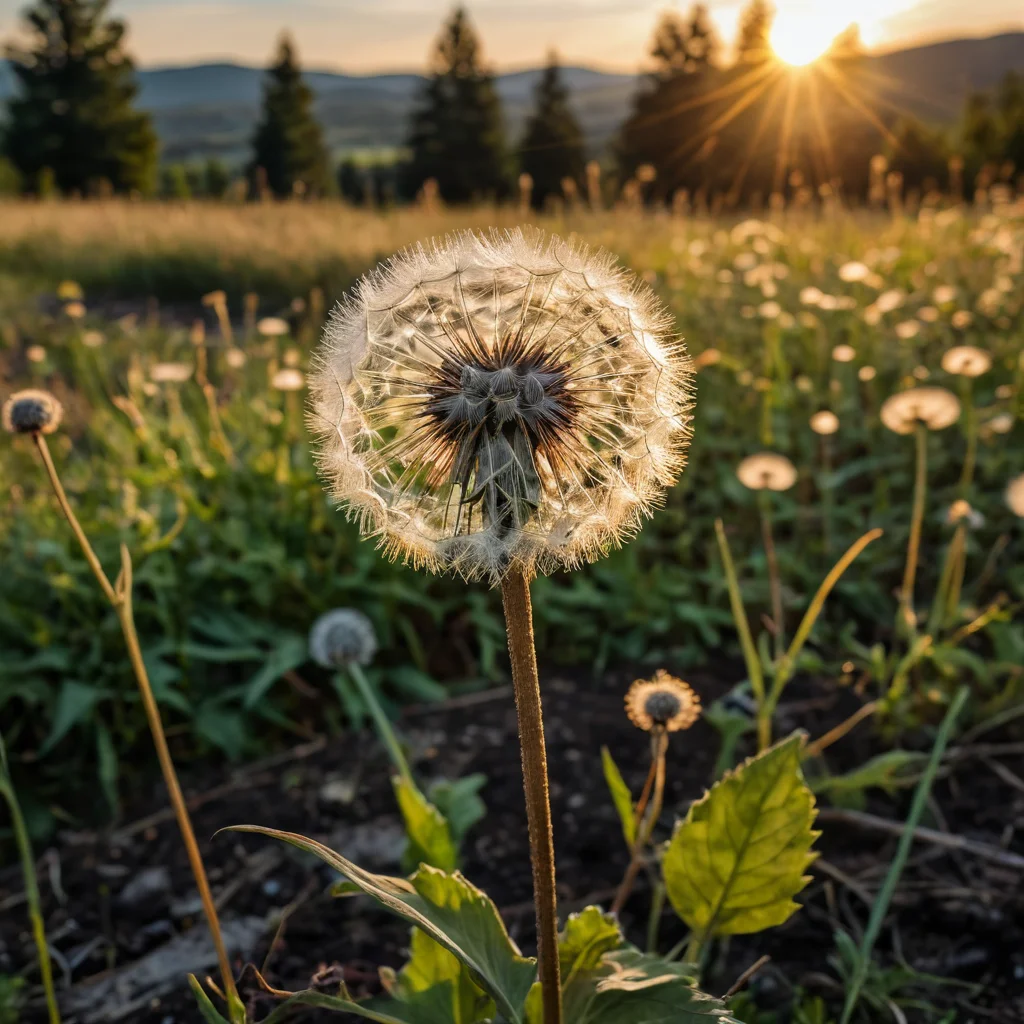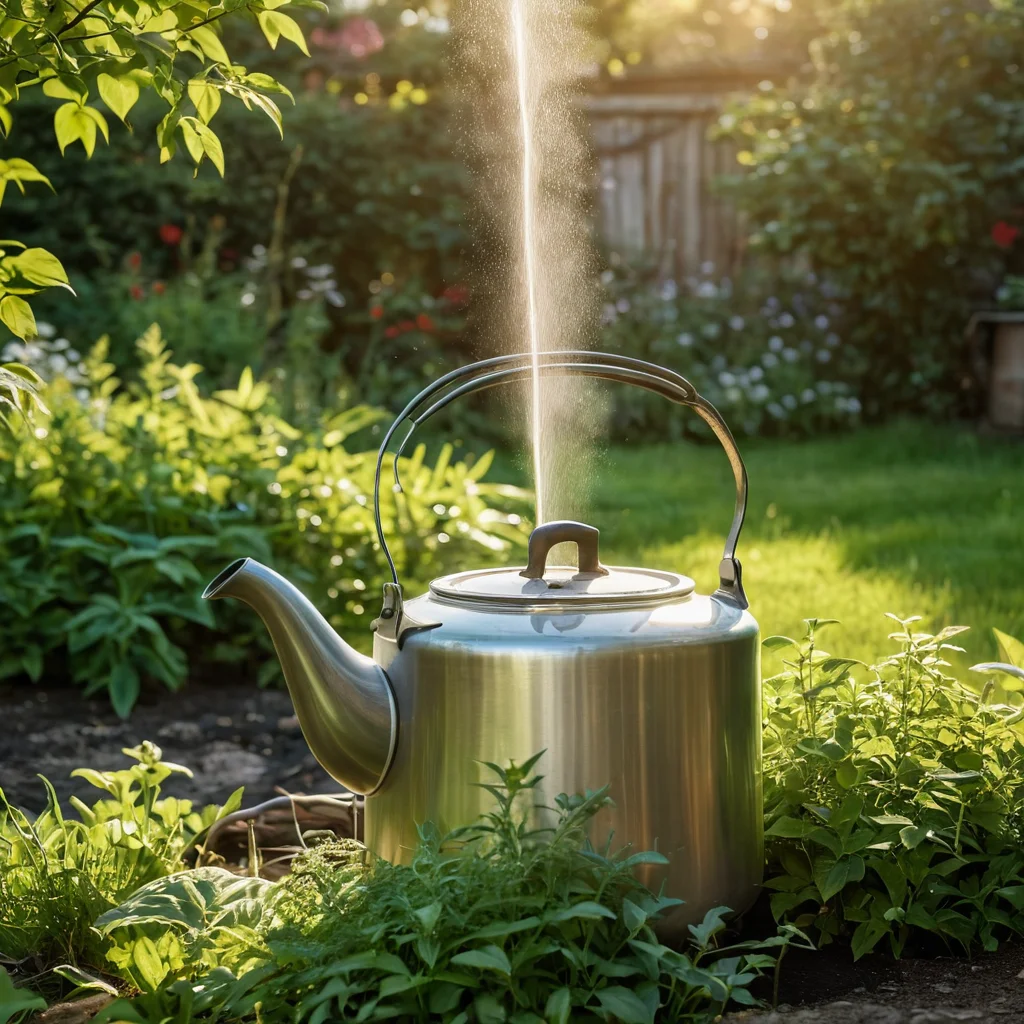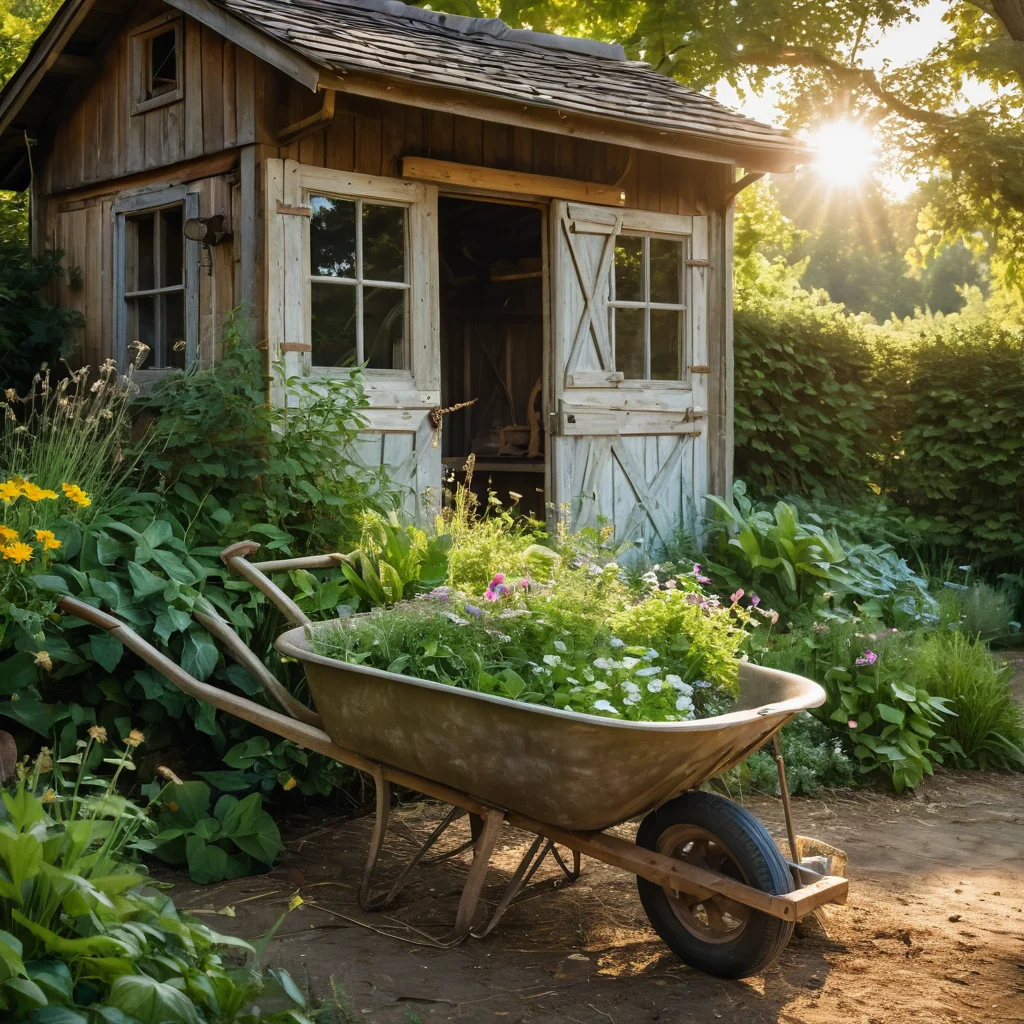Remember that special aroma that spreads over the garden beds after a warm summer rain? The earth breathes, moisture soaks into the soil, and it seems like everything around comes to life. But along with the long-awaited greenery, uninvited guests – weeds – appear on our plots just as relentlessly. They seem to race with our favorite vegetables and flowers, reaching for the sun, depriving them of precious nutrients, water, and light. Fighting them is perhaps one of the eternal battles of every gardener. But believe me, there are time-tested, simple, and, most importantly, safe for nature and our health methods that will help restore your plot to perfect order.
Why Weeds are the Gardener’s Main Problem and How Folk Methods Help Defeat Them?
Anyone who has ever weeded knows that weeds are a real headache. They not only spoil the appearance of the plot but can also completely ruin the harvest. Some of them have a powerful root system, others quickly self-seed, and still others have adapted to the most unfavorable conditions. Their tenacity is amazing! But you know what’s surprising? Nature itself suggests how to deal with them. For centuries, people have observed plants, studied their properties, and found simple but effective ways to combat them. Folk methods are not just grandmother’s tales; they are the accumulated experience of generations based on the use of accessible, environmentally friendly means. They help not only get rid of unwanted vegetation but also improve soil condition without resorting to chemical herbicides that can harm us, beneficial insects, and the earth itself. These methods are gentle on the environment and often prove to be no less effective than advertised preparations. The main thing is to know how to use them correctly.
Types of the Most Harmful Weeds on the Plot: How to Identify Them and Why They Are So Tenacious

Before declaring war, you need to know your enemy well. The same “villains” are most often found on our plots, each with its own characteristics:
- Couch Grass: Its long, tenacious roots literally entwine the soil. If even a small piece of root remains in the ground, it will sprout anew. Couch grass spreads very quickly and severely depletes the soil. It can be identified by its narrow, linear leaves and spikelet inflorescence.
- Dandelion: It might seem like a cute yellow flower, but its parachute-like seeds are carried by the wind over vast distances. And its taproot goes deep into the ground, making it very difficult to pull out whole.
- Amaranth: This plant is known for its incredible fertility. One plant can produce up to several hundred thousand seeds! Amaranth seeds retain their germination in the soil for a long time, so fighting it requires patience and persistence. It has smooth, oblong leaves and small greenish flowers gathered in dense panicles.
- Chickweed: This seemingly delicate weed is also very tenacious. It flowers and fruits almost year-round, especially favoring damp, shady places. Its thin stems break easily, but even from fragments, the plant can root.
- Stinging Nettle: Loves moist, fertile areas. Although nettle is useful, it becomes a real problem in the garden beds. Its roots spread well, and its leaves and stems are covered with stinging hairs.
- Field Bindweed: It’s hard to confuse it – it’s a climbing plant with thin, winding stems and arrow-shaped leaves. Its roots can go several meters deep into the ground! It’s a true champion of tenacity.
- White Goosefoot (Lamb’s Quarters): Another “champion” in terms of seed production. It can produce up to 1 million seeds from one plant! The seeds retain their germination for a long time, so fighting it is a constant process.
Why are they so tenacious? It’s all about their adaptability. They know how to spread quickly by seeds, have powerful roots capable of regrowing from the smallest fragments, or are simply incredibly fertile. Some of them even know how to “negotiate” with the soil, extracting everything they need from it and suppressing neighboring plants.
Salt and Vinegar: Proven Folk Remedies Against Weeds on Garden Beds and Paths

Let’s start, perhaps, with the most accessible and “aggressive” folk remedies. Salt and vinegar are real “heavy artillery” in the fight against unwanted vegetation. But they must be used wisely to avoid harm.
Salt Solutions:
- How it works: Table salt (NaCl) disrupts the water balance of plants, literally “drying” them out. When it gets on leaves and into the soil, it interferes with normal nutrition.
- How to apply:
- For paths and platforms: Here, salt is your best friend. Dissolve 50-100 g of salt in 1 liter of water. Water the weeds on paths, between tiles, and along fences abundantly. Repeat as needed. Important: do not let the solution get onto the roots of useful plants, as salt can kill them.
- Against particularly tenacious weeds (roots): If you need to destroy, for example, an old clump of couch grass or bindweed, you can try spot application of a concentrated solution (200-300 g per 1 liter). Carefully water the base of the weed.
- Attention! Do not use salt on garden beds with vegetables and flowers. Even a small amount of salt in the soil can make it unsuitable for most crops.
Vinegar (table, apple, wine):
- How it works: Acetic acid destroys plant cell membranes, causing them to wilt and die. The effect is usually visible within a few hours after application.
- How to apply:
- Concentration: Use 6% or 9% table vinegar. Apple or wine vinegar (usually 5%) will also work but may be less effective.
- Application: Spray weeds on a sunny, dry day. It works best when the plant is actively growing. Aim the spray so that it only hits the leaves and stems of the weeds.
- On paths and fences: Vinegar is an excellent solution here. Simply spray undiluted vinegar on the weeds.
- On garden beds: Be extremely careful! Vinegar can damage cultivated plants. If you need to treat a weed growing close to vegetables, use a brush or sponge to apply vinegar only to the weed’s leaves.
- Salt and vinegar mixture: For particularly “stubborn” weeds, you can mix vinegar with a small amount of salt (e.g., 100 ml vinegar + 1 tablespoon salt per 1 liter of water). But remember the harm salt can do to the soil!
- Life hack: To enhance the effect, you can add a little liquid soap to the vinegar. It will help the solution adhere better to the leaves.
Important Precautions:
- Neither salt nor vinegar are selective, meaning they kill any plants they come into contact with.
- Prolonged and frequent use of these substances can degrade soil structure, reduce its fertility, and affect its pH.
- Use them primarily in areas without cultivated plants (paths, platforms, areas for decorative stones).
Boiling Water and Baking Soda: Eco-Friendly Ways to Destroy Weeds Without Harming Plants

If you are looking for the most gentle and eco-friendly methods that are suitable even for treating areas near sensitive plants, then boiling water and baking soda are your reliable helpers.
Boiling Water:
- How it works: High temperature instantly destroys plant cell structures, causing them to die. This is the simplest and fastest way to destroy a weed “here and now.”
- How to apply:
- For paths and crevices: Simply carefully pour boiling water over weeds growing between tiles, along curbs, and in fence crevices.
- Near cultivated plants: This method requires special care. Use a watering can with a narrow spout or a syringe to direct the stream of boiling water strictly onto the weed, trying not to touch the leaves and roots of neighboring plants. It is best suited for destroying individual weeds growing at some distance from valuable plantings.
- Against young weeds: Boiling water is most effective against young, newly sprouted weeds.
- Repeat application: If the weed is very tenacious, several treatments may be necessary.
- Safety: Be very careful not to burn yourself!
Baking Soda (Sodium Bicarbonate):
- How it works: Soda creates an alkaline environment on the surface of weed leaves, which disrupts the plant’s photosynthesis and respiration processes, leading to its gradual wilting.
- How to apply:
- Concentrated solution: Dissolve 1 cup of soda in 4-5 liters of water. Stir well until completely dissolved.
- Spraying: Use this solution to spray weeds in sunny weather. Soda works best when the leaves are dry.
- On paths and in crevices: This method is safe for tiles and stones, so it is ideal for treating garden paths.
- Near plants: Soda acts more gently than vinegar or salt, but it can still damage the delicate leaves of cultivated plants. Apply the solution spot-wise or spray early in the morning or late in the evening when the sun is not active.
- Improving effectiveness: Some gardeners add a little soap or dishwashing liquid to the soda solution (1-2 tablespoons per bucket) to help it adhere better to the leaves.
Combination of Boiling Water and Soda:
- You can first sprinkle the weed with soda and then water it generously with boiling water. This will enhance the effect, as the soda will create an unfavorable environment, and the boiling water will finish off the plant.
These methods are good because they are absolutely safe for the environment, do not accumulate in the soil, and do not harm humans. However, they generally only affect the above-ground part of the plant. If the weed has a powerful root system, several treatments may be required.
Mulching with Natural Materials: How to Cover the Soil from Weeds and Retain Moisture
Mulching is a real “magic carpet” for your soil! It is not only an effective way to combat weeds but also an excellent technique for improving the health and appearance of your garden. By covering the soil with a layer of organic or inorganic material, you create a barrier to weed seed germination and also retain precious moisture.
Why Mulching Works Against Weeds:
- Light Blocking: Weed seeds need light to germinate. A mulch layer of 5-10 cm reliably blocks light from reaching the soil, preventing seeds from sprouting.
- Mechanical Barrier: Even if seeds manage to germinate, the thin sprouts of weeds cannot break through a thick layer of mulch.
- Soil Improvement (for organic mulch): As organic materials decompose, they enrich the soil with nutrients, making it healthier and more resistant to weeds.
Popular Natural Materials for Mulching:
- Mowed Grass: Free and readily available material. Use dried grass (to avoid rotting) in a thin layer, otherwise, it can clump and prevent air circulation. An excellent source of nitrogen for the soil.
- Straw or Hay: Excellent for retaining moisture and suppressing weed growth. It’s important to use clean hay (without weed seeds), otherwise, you risk seeding the plot instead.
- Wood Chips or Bark: A durable material that looks very decorative. Provides excellent weed cover and retains moisture. Decomposes over time, enriching the soil.
- Sawdust (preferably from deciduous trees): Use with caution. Fresh sawdust can “take” nitrogen from the soil. It’s better to compost it beforehand or use it as a top layer, mixed with other materials.
- Compost: An ideal material that both fertilizes and protects against weeds.
- Leaves (fallen): An excellent free resource in autumn. Shred them with a garden vacuum or lawnmower so they decompose faster and don’t clump.
- Newspapers or Cardboard: An excellent budget-friendly option. Lay several layers of newspapers (without colored ink) or thick cardboard around plants, and then mulch with grass, bark, or compost. This will reliably stop weed growth.
How to Mulch Correctly:
- Preparation: Before mulching, be sure to remove all large weeds that have already sprouted.
- Layer Thickness: Usually, a layer of 5-10 cm is sufficient. For bark and chips, the layer can be thicker (up to 15 cm).
- Distance from Trunks: Leave a small gap (2-5 cm) around the trunks of trees and shrubs, as well as around the base of vegetable plant stems. This will prevent rotting and help avoid attracting pests.
- Regularity: Organic mulch needs to be replenished periodically as it gradually decomposes.
Mulching is not only protection against weeds but also a way to make your garden more well-groomed, reduce labor costs for watering and weeding, and improve soil structure.
Manual Weeding: Secrets of Effective Root Removal of Weeds

Yes, no matter how hard we try to automate the process, manual weeding is still indispensable in the dacha. It is the most precise and reliable way to get rid of weeds, especially if done correctly. The main goal is to remove the weed along with its root!
When is the Best Time to Weed:
- After rain or watering: Moist soil becomes loose, and roots are easily removed. This is the ideal time to pull out the weed whole, leaving no fragments in the ground.
- While weeds are small: The younger the weed, the weaker its root system, and the easier it is to remove. Don’t let them grow and produce seeds!
- Regularly: It’s better to spend 15-20 minutes weeding every day or every other day than to spend a whole weekend on it.
Effective Weeding Technique:
- Hold at the base: Try to grab the weed as low as possible, at the very ground. This reduces the chance of it tearing.
- Move carefully: Don’t yank sharply. Gently rock the weed from side to side to loosen its grip on the soil, then pull it up smoothly.
- Use tools: For deeply rooted weeds (dandelion, sow thistle), special tools will be indispensable assistants:
- Root remover (fret saw): Has a narrow blade that is convenient for prying and pulling out taproots.
- Garden forks or a narrow trowel: Help loosen the soil around the root and carefully extract it.
- Knife or hoe: For removing annual weeds or cutting down perennial weeds at ground level (but this won’t get rid of the root).
- Remove with the root: This is the most important rule! If you leave even a part of the root in the ground (especially for couch grass, sow thistle, bindweed), it will sprout again.
- Don’t scatter: It’s best to immediately collect pulled weeds into a bucket or wheelbarrow. Don’t leave them lying on the garden bed, especially if they have seeds or you removed them with seeds – they can root again or infect the soil.
- Maintain distance: When weeding a garden bed, try not to walk on the bare ground to avoid compacting it and creating new places for weeds to sprout.
Throw away or use?
- Weeds collected without seeds and diseases can be sent to the compost.
- Weeds with seeds or signs of disease are best burned or removed from the plot.
Manual weeding is a kind of meditation. When you thoughtfully and methodically remove each weed, you not only bring order but also better feel your land, understand its needs.
How to Prevent Weeds: Prevention and Folk Life Hacks

The best fight against weeds is their prevention. If you create unfavorable conditions for their growth on the plot, you will have to weed much less often. Here are a few proven methods:
- Healthy and dense lawn: A well-maintained, dense lawn leaves no chance for weeds. Mow the grass regularly, water, and fertilize the lawn.
- Proper crop rotation: Alternate crops in the garden beds. Some weeds prefer certain soil types or conditions, and crop rotation helps disrupt their life cycle.
- Do not allow flowering and seed formation: The main rule is not to let weeds flower and produce seeds. Remove them before this stage. Even one weed that leaves seeds can “provide” you with work for several years to come.
- Clean tools: After working in an infested area, thoroughly clean shovels, hoes, and other tools of soil. They may carry seeds or root fragments.
- Use clean compost: Ensure your compost is fully mature and free of weed seeds. Sometimes it’s better to buy proven compost than to use “homemade” but full of surprises.
- Soil covering (black mulch): In areas you plan to plant later, or in empty beds, you can use black covering material (spunbond) or even thick cardboard. This completely blocks light and suppresses the growth of any plants underneath.
- Planting green manures: These are plants grown not for harvest but to improve the soil. Many green manures (mustard, phacelia, rye) grow so quickly and densely that they simply “suffocate” weeds, and then their green mass can be incorporated into the soil as organic fertilizer.
- Creating “hedges” and flower beds: Dense plantings of ornamental shrubs, flowers, or perennial grasses create a dense cover that prevents weed growth.
- Limiting water access: Some weeds, like chickweed, love excess moisture. Ensure your plot is well-drained and do not overwater the soil unnecessarily.
Prevention is the key to success. The fewer weeds manage to sprout and produce seeds, the easier it will be for you to maintain order on your plot.
Common Mistakes When Combating Weeds with Folk Methods and How to Avoid Them
Even the most proven methods can be disappointing if applied incorrectly. Let’s analyze typical mistakes so that your efforts are not in vain:
- Mistake 1: Using aggressive substances on garden beds.
Problem: Salt and concentrated vinegar, when they get into the soil of garden beds, can make it unsuitable for most crops, killing beneficial soil inhabitants. Even a small amount can be harmful.
How to avoid: Use salt and vinegar mainly on paths, platforms, in crevices, and other places where there are no cultivated plants. For garden beds, choose gentler methods: manual weeding, mulching, boiling water (spot treatment and with caution). - Mistake 2: Not removing weeds by the root.
Problem: You pulled out only the top, but the root remained. Couch grass, sow thistle, bindweed, and other perennial weeds will grow back, often with doubled force.
How to avoid: Always try to pull out the weed whole, especially if it is perennial. The best time is after rain. Use tools to pry out roots. - Mistake 3: Leaving pulled weeds on the garden bed.
Problem: Weeds with still viable roots or seeds left in the sun can root again or spread their seeds throughout the plot.
How to avoid: Immediately collect pulled weeds into a bucket or wheelbarrow and remove them from the plot (if they are diseased or have seeds) or send them to the compost (if clean). - Mistake 4: Weeding too infrequently.
Problem: Waiting until weeds grow large and cover the entire bed. This increases labor costs significantly and raises the risk of them producing seeds.
How to avoid: Weed regularly. It’s better to spend 15 minutes every day than 3 hours once a week. - Mistake 5: Using unripe or contaminated compost.
Problem: Instead of benefit, you bring new weed seeds or disease pathogens to the plot.
How to avoid: Make sure your compost is well-rotted (no recognizable plant remains, smells like earth). If in doubt, it’s better to use store-bought or carefully check homemade compost. - Mistake 6: Not considering weather conditions.
Problem: Spraying herbicides (even folk ones) in windy weather can lead to the substance getting onto cultivated plants. Vinegar and soda are less effective in rainy weather.
How to avoid: Spray in calm, dry weather. Water with boiling water carefully, directing the stream. - Mistake 7: Relying solely on one method.
Problem: One method is rarely universal. What works on a path can harm a garden bed. What kills the above-ground part doesn’t always destroy the root.
How to avoid: Combine methods. Use mulching for prevention, manual weeding for spot removal, vinegar or salt for paths, boiling water for “emergency” help.
Fighting weeds is a continuous process, but by applying folk methods with wisdom and patience, you can make your garden clean, well-groomed, and a truly heavenly corner without harming yourself or nature.
